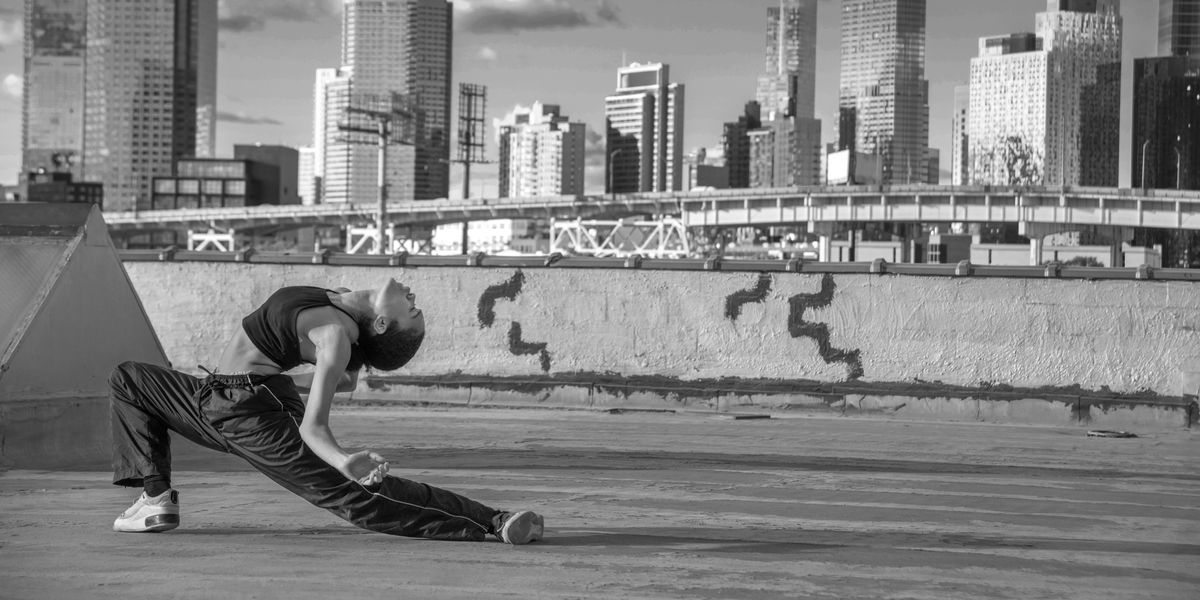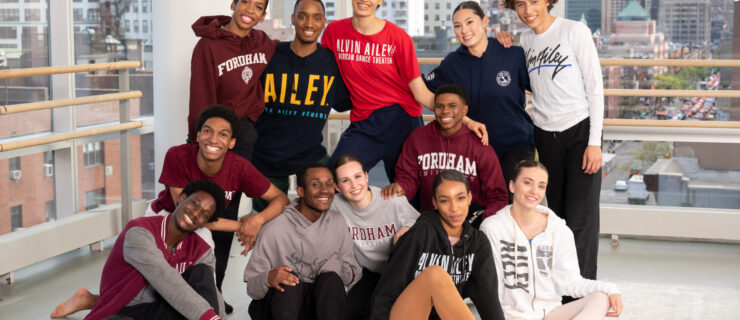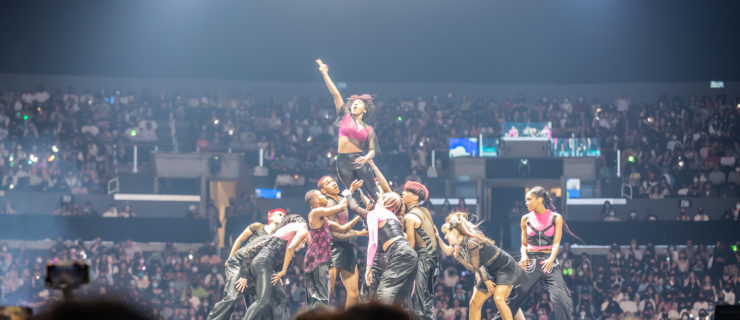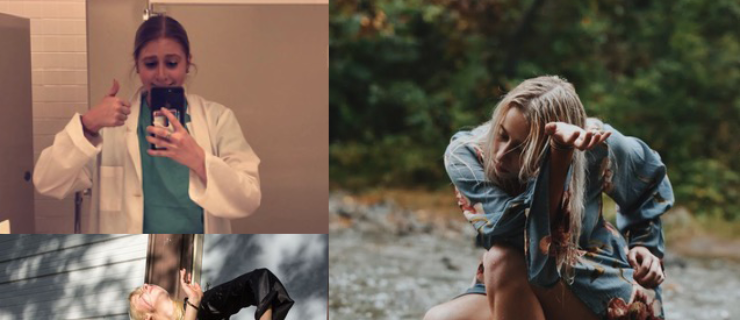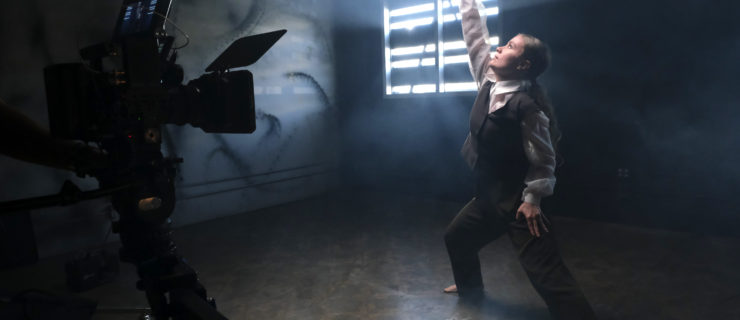Diversify Your Training and Open New Doors at Marymount Manhattan College
No two dancers’ career paths are exactly alike…which is actually pretty great! Equally great: New kinds of opportunities are constantly cropping up in the dance world, along with new skills necessary to book them. (Did anyone really know how to make a self-tape before 2020?) But in an industry that seems to quick-change faster than you did at your last recital, how can you be certain which skills will be the most important for you to have on your unique dance journey? The short answer: You can’t. Luckily, though, with the right foundation, you can feel confident in any environment, whatever road you dance down.
Enter Marymount Manhattan College, a liberal arts school in the heart of NYC. From Broadway to ballet to the big screen, if you can dream of doing it, Marymount’s BA and BFA dance programs provide the tool kit you’ll need to get there.
Dance Spirit
caught up with four Marymount Manhattan alumni to hear how the diversity of their training has helped them navigate postgrad life.
Samantha Butts

Samantha Butts (front left) in rehearsal with the Rockettes
Courtesy Butts
Hailing from a competition-dance background in Columbus, OH, Samantha Butts knew she wanted a career in dance, especially one in NYC. “I wanted to explore Broadway, as well as contemporary and concert work, but also get a strong education,” she shares. “Doing my research, I discovered Marymount and knew it was the perfect place to prepare for all of those avenues.”
Settling on a modern dance concentration while also taking classes in ballet, jazz, contemporary, and commercial jazz, Butts was surprised not only by the amount of dancing, but of learning about dance, as well. “I went into school thinking that it was going to be all physical. But Marymount exposed me to so much of the history and background of dance that I hadn’t even considered before.” Particularly, Butts’ professors challenged her to communicate as strongly with words as with her movement. “I had always hated public speaking, but I came to realize that being able to speak up, explain your movement and communicate how it feels is so important as a professional,” she says.
Aside from dancing every day, Butts had the opportunity to flex other creative muscles. “I got to take graphic design and fashion classes, which I loved connecting to my favorite dance brands, and eventually led to me designing my own dance website,” she explains.
When it came to her senior year, Butts still wasn’t dead-set on a specific career path, but she was confident she had the tools necessary to succeed in dance. “I was exposed to so many different styles, ideas and people at Marymount. It was overwhelming at times, but by the end, I was confidently audition-ready,” she says. After auditioning for several different opportunities, Butts performed as a Radio City Rockette in the 2019 Christmas season. When the pandemic hit, she took up teaching virtually and at her hometown dance studio, and has since expanded her teaching to include dance cardio with Body by Simone. “I never thought I would develop such a love for teaching,” she says. “But Marymount gave me all of these tools, like knowing my anatomy, how to present myself professionally and how to communicate concepts, and navigate outside my comfort zone. All the boxes I needed were ticked to feel prepared to step into something totally new.”
Jacob Larsen

Jacob Larsen
Courtesy Larsen
Martha Graham Dance Company member Jacob Larsen transferred to Marymount Manhattan after completing a year at community college, and immediately immersed himself in the college’s vibrant student body. “Marymount is the best place to meet a ton of dancers, but you also meet actors, students working in production and costumes, future physical therapists—all these people who also have one foot in the dance world,” he says. “I was enamored with NYC, and the people around me made me fall even more in love with dance.”
For his ballet concentration, Larsen took classes in men’s technique and partnering, but soon also found himself gravitating towards extra modern technique classes. “Learning the history behind dance, I was fascinated by modern-dance pioneers like Martha Graham,” Larsen explains. “I loved how she wasn’t afraid to make bold statements and break the rules.” After graduating in 2015, Larsen attended Springboard Danse Montréal, where he performed works by Alexander Ekman and Banning Bouldin. Then, he was accepted into Graham 2, and joined Graham’s main company a year later. “Graham technique is extremely physical and challenging,” Larsen says. “But Marymount helped me develop such a strong technical foundation and awareness of my own body. As I like to say, anatomy is forever!”
What else is on his dance bucket list? Larsen envisions anything from Broadway to touring to performing with a pop star, in part because he’s seen his fellow alumni succeed at all of the above. “Marymount is a very close-knit community on the Upper East Side,” he says. “But once you leave, you realize, ‘Oh, my gosh, there are MMC alumni all over, doing every kind of job.’ ”
Lauryn Hayes

Lauryn Hayes
Effy Grey Photography, Courtesy Hayes
Growing up in League City, TX, Lauryn Hayes trained in ballet, jazz, contemporary and hip hop, and spent summers dancing at The Ailey School in NYC. “It was my dream to move to NYC and dance, and I wanted a college program where I could get really great ballet training as well as dive into modern and other styles,” she says. “It was that curiosity that brought me to Marymount.” At school, Hayes immediately felt like a small fish in a big pond. “Marymount’s program was humbling at first,” she says. “All my classmates and I were probably the best back at their home studio, but the intensity of training and exposure to so many different dance styles at Marymount is definitely a big wake-up call to what dancing on a professional level is like.”
Hayes started off with a jazz concentration in the BFA program, but by her junior year, she had switched to ballet, as well as added a second major, in business. Marymount Manhattan’s dance curriculum revealed other new interests, as well. “It was such a happy accident that certain academic dance courses are required,” Hayes says. “In Cultural History of Dance and Critical Approaches to Dance, I discovered my love for cultural anthropology and the politics of art.”
After graduating earlier this year, Hayes is already #BookedAndBusy, thanks to the connections she made in school—but not in the ways you’d think. “The jobs I’ve had so far have actually all come from professors I didn’t necessarily take from at Marymount, but still had the chance to learn from and network with, since it’s such a tight-knit community,” Hayes explains. Those opportunities have included joining Andrea Miller’s renowned company, Gallim, for a two-month commission at Lincoln Center, as well as dancing in Deep Blue Sea, a work by Bill T. Jones, which just wrapped up a run at the Park Avenue Armory in NYC. “My professors at Marymount were constantly pushing me and were invested in my success,” Hayes shares. “Performing in such an iconic NYC venue as Lincoln Center with three of them in the front row cheering me on was a full-circle moment.”
Moving forward, Hayes hopes to further explore all of the doors that Marymount opened up for her. “I really enjoy modern and postmodern dance, and also academia,” she says. “Down the road, I would love to become a professor of African-American studies or gender studies, alongside my dancing.”
Lexi Garcia

Lexi Garcia backstage at Hamilton, with Lin-Manuel Miranda
Courtesy Garcia
Florida native Lexi Garcia still vividly remembers the first time she walked into Marymount Manhattan for her BFA dance audition. “From taking in the beautiful campus to the professors leading my audition, the energy and encouragement felt completely aligned with what I wanted out of my college experience,” she recounts. What Garcia didn’t quite expect was for Marymount to completely flip her idea of technique on its head. “Coming from a competition background, I quickly realized I had to rewire my brain to focus on longevity,” she says. “If I wanted to dance professionally, I couldn’t just crank my leg up or jam my turnout. My training at Marymount was a lesson in working with and celebrating what I’ve got.” The ultimate payoff of rebuilding her technique on a college level, according to Garcia, was consistency. “When you truly understand your technique, there’s no more ‘good’ and ‘bad’ turn days. You know that whenever a choreographer asks for something, you’re able to deliver.”
Although Garcia pursued the modern concentration at Marymount Manhattan, after graduating in only three years, she was happy to discover how her training equipped her to grand-jeté in a new direction: musical theater. “When I started going to open calls, I realized it was a very similar environment to all of the times I worked with guest choreographers in school,” she explains. “Your adrenaline is pumping, and you want to impress everyone in the room and stay open to whatever they’re throwing at you. Knowing I had done that before definitely helped my confidence.”
After contracts with Norwegian Cruise Lines and regional theaters, Garcia got the call she’d been dreaming of. “I had auditioned for the Philip cast of Hamilton ‘s North American tour before, but they explained that someone in the Broadway cast was pregnant and they needed a replacement,” she says. In 2017, she made her Broadway debut.
Nowadays, Garcia is passing on all of the valuable lessons she’s learned to her students at East Coast Performing Arts, while plotting yet another career switch-up, this time as a performer at Disney World in Orlando, FL. “My family lives in Florida, and it’s my dream to be able to perform for them and be a part of such a magical place for entertainment,” she says.
Overall, Garcia’s time at Marymount planted seeds of insight that she’s continued to develop across the span of her dance journey. “When I first came to Marymount, I had this perspective of making everything happen all by myself,” Garcia says. “But Marymount introduced me to the ideas of community and balance. I realized that if I’m going to survive in this industry, I need other people to help keep me going, and at Marymount, I found those people.”
